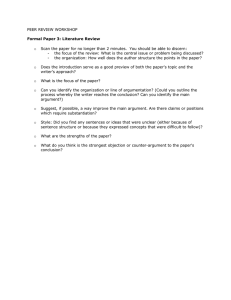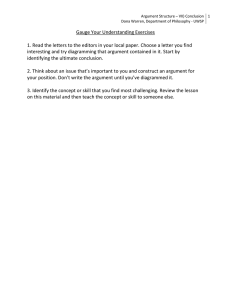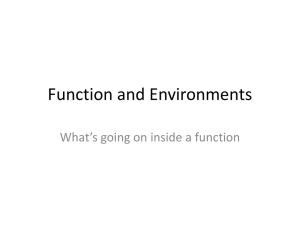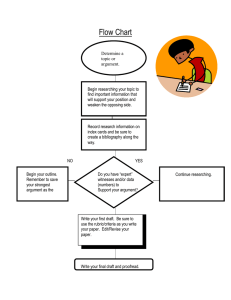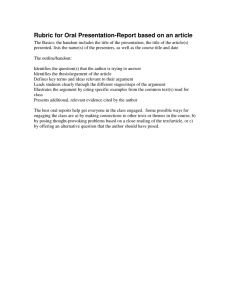Project as presented to candidates
advertisement
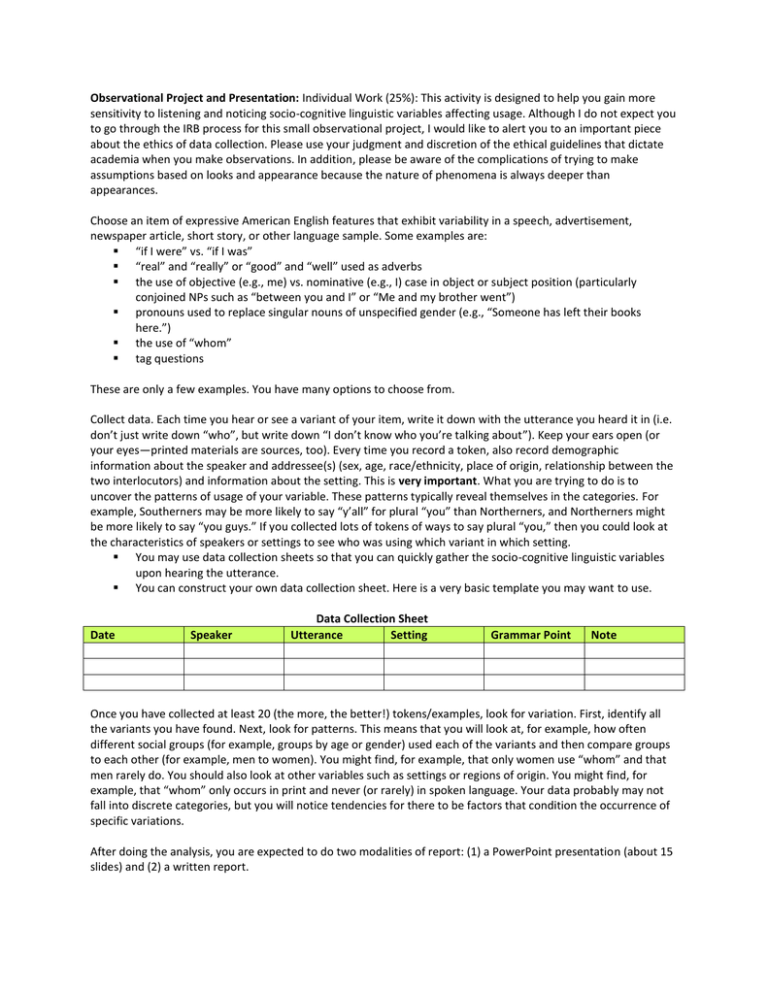
Observational Project and Presentation: Individual Work (25%): This activity is designed to help you gain more sensitivity to listening and noticing socio-cognitive linguistic variables affecting usage. Although I do not expect you to go through the IRB process for this small observational project, I would like to alert you to an important piece about the ethics of data collection. Please use your judgment and discretion of the ethical guidelines that dictate academia when you make observations. In addition, please be aware of the complications of trying to make assumptions based on looks and appearance because the nature of phenomena is always deeper than appearances. Choose an item of expressive American English features that exhibit variability in a speech, advertisement, newspaper article, short story, or other language sample. Some examples are: “if I were” vs. “if I was” “real” and “really” or “good” and “well” used as adverbs the use of objective (e.g., me) vs. nominative (e.g., I) case in object or subject position (particularly conjoined NPs such as “between you and I” or “Me and my brother went”) pronouns used to replace singular nouns of unspecified gender (e.g., “Someone has left their books here.”) the use of “whom” tag questions These are only a few examples. You have many options to choose from. Collect data. Each time you hear or see a variant of your item, write it down with the utterance you heard it in (i.e. don’t just write down “who”, but write down “I don’t know who you’re talking about”). Keep your ears open (or your eyes—printed materials are sources, too). Every time you record a token, also record demographic information about the speaker and addressee(s) (sex, age, race/ethnicity, place of origin, relationship between the two interlocutors) and information about the setting. This is very important. What you are trying to do is to uncover the patterns of usage of your variable. These patterns typically reveal themselves in the categories. For example, Southerners may be more likely to say “y’all” for plural “you” than Northerners, and Northerners might be more likely to say “you guys.” If you collected lots of tokens of ways to say plural “you,” then you could look at the characteristics of speakers or settings to see who was using which variant in which setting. You may use data collection sheets so that you can quickly gather the socio-cognitive linguistic variables upon hearing the utterance. You can construct your own data collection sheet. Here is a very basic template you may want to use. Date Speaker Data Collection Sheet Utterance Setting Grammar Point Note Once you have collected at least 20 (the more, the better!) tokens/examples, look for variation. First, identify all the variants you have found. Next, look for patterns. This means that you will look at, for example, how often different social groups (for example, groups by age or gender) used each of the variants and then compare groups to each other (for example, men to women). You might find, for example, that only women use “whom” and that men rarely do. You should also look at other variables such as settings or regions of origin. You might find, for example, that “whom” only occurs in print and never (or rarely) in spoken language. Your data probably may not fall into discrete categories, but you will notice tendencies for there to be factors that condition the occurrence of specific variations. After doing the analysis, you are expected to do two modalities of report: (1) a PowerPoint presentation (about 15 slides) and (2) a written report. The PowerPoint slide should be clearly laid out as you make an oral presentation, and include visual graphics, such as graphs and tables, to report the results of your observation. You will present your project to your classmates in the last class session. Both types of report should describe: the aspect of American English that you have collected your data on how you collected your data the variants you have discovered an analysis of your data with a table for each of the analytic categories that you found to demonstrate patterning (e.g., Table 1: that variant as it is distributed by gender, Table 2: the variant as it is distributed by age, Table 3: the variant as it is distributed by setting, etc.) A written report is to be 10 pages long at maximum, including a cover page, tables/graphs, and references. The APA format is to be used. You can turn in a term paper on the last day of class or submit it via the Digital Dropbox on Bb by 11:59 p.m., 6/6/10. This is not a big project, although it may sound like it. If you open your ears and eyes in your daily activities with increased awareness, you will get this project done very easily. A raised awareness matters! Grading Rubric Elements Grading Rubric Incomplete Acceptable Exemplary Title Vague as a whole Presents a picture of the body but unclear Clearly captures the body as a whole Organization Weak logical flows; Needs further development in the structure of the argument. Sequence is clear and major components are presented, but the argument is not supported in a logical fashion. Objectives/Goals Objectives are missing, unclear, or inappropriate Objective(s) are clearly stated; provides purpose, but main goals/objectives in relation to previous research are not provided Well organized with the major components of a prose (intro, body, and conclusion); aligned with the scope and sequence of the argument; logical structure and step-by-step sequence Objectives are measurable with precise research questions; connections are made between previous research and the present argument/research questions; Evidence/Literature Review Shows a weak relevance from previous research to a topic under consideration Most prior knowledge and concepts are clearly articulated but some important skills are missing Explanation/argumentation is supported by evidence and examples that are clearly attributed to sources for which proper citations are provided Content Shows flaws or deficits in understanding of the topic and inabilities to integrate prior knowledge and a research topic into a paper Methods are appropriate and marginally matched to the objectives/goals of the paper. Well developed; clear and logically coherent explanation and argumentation that fully respond to the question(s) posed. Unity Lack of unity; a sloppy argument without supporting materials. Some coherence is found by insufficient to achieve a whole unity. Demonstrates a clear continuity from the beginning to the end; lays out the argument in a logical and convincing form. Conventions and Mechanics Needs improvements in terms of writing mechanics. Partially meets the writing conventions and shows frequent grammatical errors; too many quotations A clear, grammatical English prose; credits to sources are given, using the APA style; quotations are kept to an absolute minimum Reflection Lack of critical reflection No clear critical reflection Clearly articulate original and critical insights into the given topic; states implications of the argument made.

